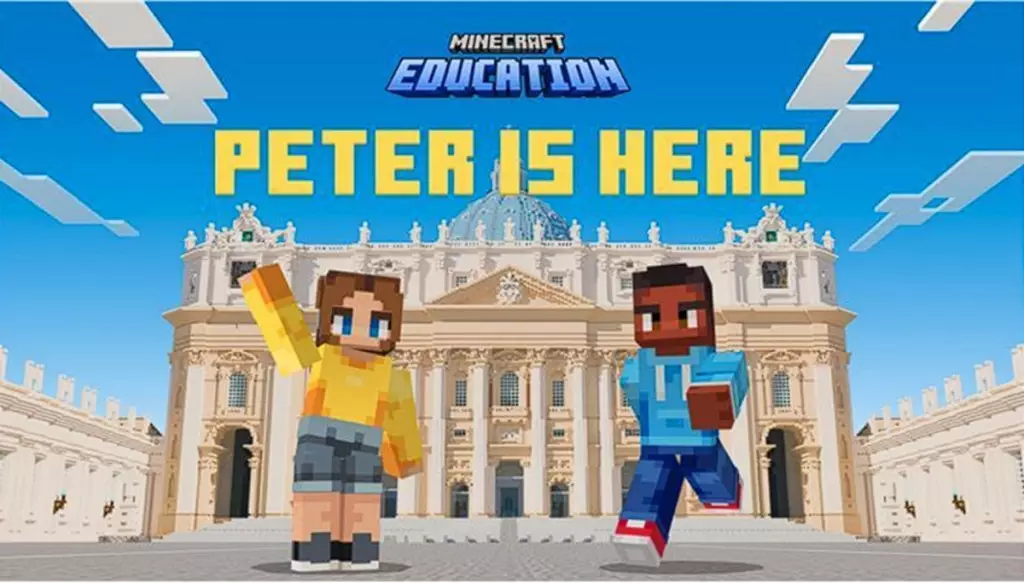In an age where technology intertwines seamlessly with education, the intersection of artificial intelligence (AI) and cultural heritage preservation emerges as a groundbreaking frontier. This innovative narrative finds its voice in the newly launched Minecraft Education experience, “Peter Is Here.” Developed collaboratively by Microsoft and the Vatican, this initiative offers students a unique opportunity to dive into the iconic St. Peter’s Basilica, transforming them from mere spectators of history into active participants in its preservation. This approach not only fosters a deep appreciation for historical monuments but also equips young learners with essential skills in problem-solving and critical thinking.
At its core, “Peter Is Here” goes beyond fostering mere engagement; it serves as a vital educational tool. With the grandeur of St. Peter’s Basilica as its backdrop, the program facilitates an exploration of not only the building’s architectural brilliance but also its historical significance across the ages. Combining hands-on restoration tasks with gamified learning enhances the immersive experience, turning students into Sanpietrini—dedicated caretakers tasked with maintaining this cultural treasure.
Engagement through Interactive Learning
What sets “Peter Is Here” apart from typical educational tools is its innovative blend of AI technology with immersive gameplay. Students begin their journey within a framework ostensibly rooted in tradition, yet they are equipped with cutting-edge tools that not only engage them but also deepen their understanding of heritage conservation.
During the initial phase, termed “Restoration Mode,” students engage in hands-on projects that require their direct involvement to preserve St. Peter’s Basilica. This hands-on approach challenges learners to think critically about the decisions they make, as each choice visually impacts the site. By navigating complex restoration tasks tied to historically significant periods—ranging from the Vatican Obelisk to Bernini’s Baldachin—they cultivate an appreciation for the intricate balance between preservation and innovation. This method engages students in active learning, transforming them from passive recipients of history into informed stewards of cultural heritage.
Furthermore, the incorporation of AI tools allows students to scan and assess damage, reinforcing a tech-savvy angle to the learning experience. Institutions like Microsoft have long championed integrating technology into educational frameworks. However, “Peter Is Here” elevates this goal to a new level by placing AI—often seen merely as a futuristic gadget—at the forefront of cultural dialogue and engagement.
Exploration and Discovery: The Journey Continues
Once students have completed their restoration tasks, they shift into “Exploration Mode,” which invites them to roam the Basilica’s grand halls and uncover secrets hidden in its history. This transition from restoration to exploration is a thoughtfully designed mechanism that enhances the learning experience. While navigating through the beautifully reconstructed space, students interact with historical figures like Michelangelo and Bernini, engaging in conversations that breathe life into the narratives they uncover.
These interactions are more than mere storytelling; they are dialogue-driven encounters that provide contextual depth. The game essentially transforms players into historical detectives, allowing them to piece together the rich tapestry of St. Peter’s legacy. This method of experiential learning fosters a profound connection between the learners and the past, cultivating a sense of responsibility toward preserving cultural heritage for future generations.
Furthermore, the incorporation of creative documentation through in-game tools like the Book and Quill allows students to reflect on their experiences while encouraging critical thinking. By sharing their insights, they create bridges between history and communal learning, ultimately positioning themselves as active participants in safeguarding cultural narratives.
Educators as Facilitators of Cultural Literacy
Beyond its interactive gameplay, “Peter Is Here” offers a substantial resource for educators eager to integrate modern tech into their curricula. With supplementary materials, lesson plans, and corresponding workbooks available for download, teachers can seamlessly facilitate the usage of Minecraft Education in their classrooms. This aspect ensures that the learning experience remains structured yet flexible, catering to diverse educational needs while enriching students’ understandings of history, art, and digital literacy.
Moreover, by grounding education in cultural literacy, the program expands students’ horizons. They learn not only about the architectural styles and construction techniques of various eras but also about the importance of preserving the legacy of human creativity. The unique hands-on experience broadens the scope of what it means to be an active citizen in today’s world, instilling a critical understanding of history that transcends traditional learning methodologies.
Encouraging students to engage not only with the mechanics of preservation but also with its implications reflects a pivotal shift in how we teach history and technology. By recognizing the interconnectedness of cultural heritage and modern innovation, “Peter Is Here” encapsulates the essence of contemporary education: a blend of knowledge, creativity, and responsibility toward our shared heritage.

